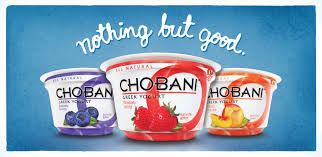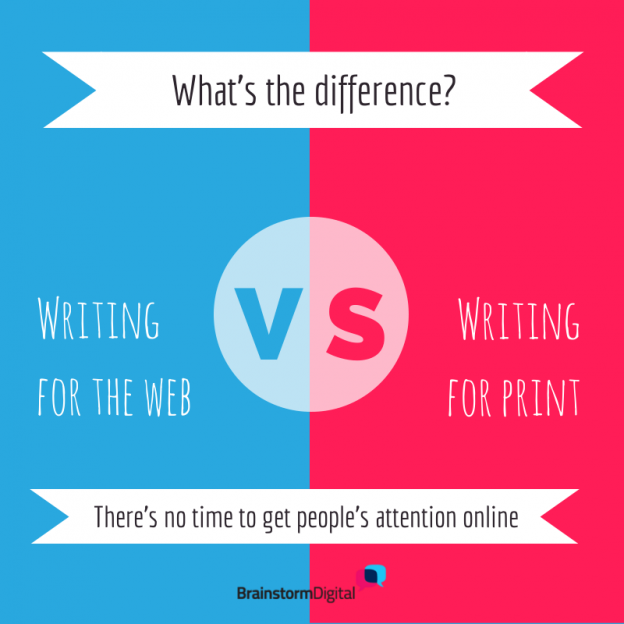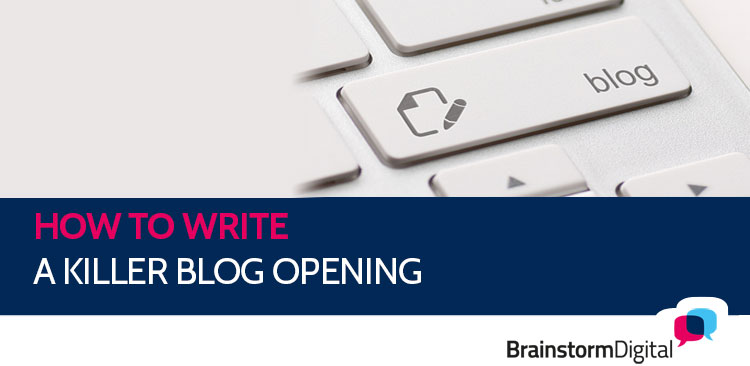 “It’s forty degrees out and there’s a guy standing in front of the office building, shivering, indulging in his nicotine addiction. I can’t possibly empathize with what he’s thinking or feeling.”
“It’s forty degrees out and there’s a guy standing in front of the office building, shivering, indulging in his nicotine addiction. I can’t possibly empathize with what he’s thinking or feeling.”
That opener to a piece by entrepreneur Seth Godin certainly caught my attention in a way that most blogs about mass marketing would not. The image is vivid and startling, and I immediately knew that the post would be equally powerful.
This is why that initial paragraph is crucial to the success of your entire post.
Research has shown that it is critical to grab your readers’ attention within first 10 seconds; it is not until they’ve been on your page for 30 seconds that the likelihood of them leaving drops dramatically. If your opening is not brilliant, chances are that they will never get any further (congratulations, by the way, for getting them past the headline – a hurdle in and of itself!).
So how to draw your readers in? Here’s some great news: You don’t have to re-invent the wheel. There is a finite number of opening styles that will have impact – and here there are, for you to steal adjust in your next post:
Get straight to the point
“An Oklahoma City doctor has prevailed in her long running legal battle against a Botox manufacturer….”, according to the Pharmagossip blog.
We certainly know what the story is about now. Getting straight to the point provides readers with immediate opportunity to decide whether this is a topic they are interested in. If it is, they’ll read on…
This style is most often used for straight news reports, or perhaps updates about your company (such as this recent announcement by Evernote: “Evernote just hit a major milestone: 100 million users in 190 countries around the world”). Make sure that your piece of news is interesting enough to deserve it!
State the problem
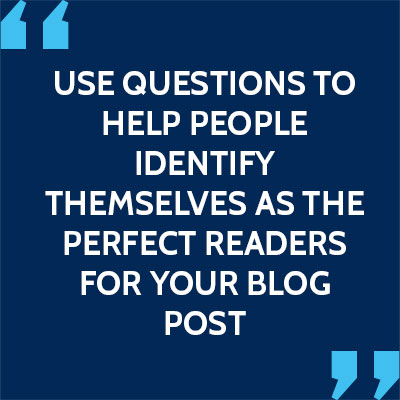 The best business blogs directly address a problem experienced by the company’s clients. For example, if you are offering a hay fever treatment, you might want to write about hay fever’s symptoms, or treatment options.
The best business blogs directly address a problem experienced by the company’s clients. For example, if you are offering a hay fever treatment, you might want to write about hay fever’s symptoms, or treatment options.
It’s often to state the problem they are grappling with immediately at the outset:
“Do you suffer from hay fever?”
Or, more specifically, “Are you unsure whether your symptoms are hay fever?” or “Confused about the treatments available for hay fever?”
If the answer is yes, you will grab your prospects’ attention immediately, and create a personal connection because you have shown you understand their concerns.
From a marketing perspective, you’re spelling out exactly who the blog post is meant for, helping the ‘right’ readers identify themselves.
Ask an intriguing question
 “What do Don Draper and Steve Jobs have in common and why does it matter?” (The Huffington Post)
“What do Don Draper and Steve Jobs have in common and why does it matter?” (The Huffington Post)
An unexpected question will amuse and involve the reader, giving them an incentive to read further into the post. If you can delay giving an answer until quite far down, even better!
Be controversial
State your opinion upfront:
“Pharmaceutical regulation is far too lax and ought to be tightened up. No doubt whatsoever”.
Readers might disagree, but they’ll probably keep on reading to see whether you can back up your strong views. Everyone will have formed an opinion on this piece by the end of the first sentence, and will either enjoy reading an article that expresses exactly what they have always thought – or fume at opinions that enrage them. Research has shown that pieces that provoke anger are more viral, so this is not necessarily a bad thing!
Make a claim or a promise
“My fabulous medicine can increase hair growth by 50% in 10 days” will certainly grab a reader’s attention – but you have to be able to back this up. Although so much on the internet is unregulated, if readers try out your claim and find it to be untrue, the comments section of your blog will be inundated with complaints blog pretty quickly.
Definitely only try this out if you are extremely confident about your product. And be wary of turning your entire blog into one long marketing pitch.
Tell a story
“In 2005, Hamdi Ulukaya purchased a yogurt factory in upstate New York that had been shuttered by Kraft Foods. He wanted to use it to produce a line of strained, or ‘Greek’ yogurt called Chobani. If you’ve been in a grocery store lately, you probably know the rest – the brand caught on quickly.” (Harvard Business Review blog)
Readers are far more likely to remember stories than facts and figures. Kicking off your post with one will immediately bring your subject to life, and draw in readers who might be turned off by a more ‘direct’ approach.
When your subject is a little dry (like yogurt – liquidity notwithstanding!), a story can make it much more accessible, and perhaps even attract readers who would otherwise assume that your blog post is not for them.
This works particularly well if the story you tell is your story – if you can make it personal.
Create an intriguing picture
A variant on “tell a story”. Sometimes, you can invite the reader to picture themselves in a certain scenario:
“Imagine giving up work, cruising round the world and having no more taxing decisions to make apart from what to order from room service. This is the life you could be leading if you had invested in company X when it floated five years ago. Now that its shares have increased by 700%, those who did invest are wondering what to do with all their money.”
This works particularly well if you are going to discuss a moral or business dilemma, or if you want to help your readers picture themselves either floundering without your product – or succeeding because of it!
Use current affairs as a hook
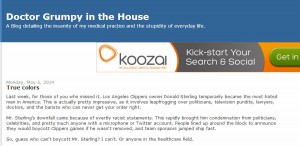 “Last week, for those of you who missed it, Los Angeles Clippers owner Donald Sterling temporarily became the most hated man in America”, Drgumpyinthehouse, an American medical doctor, opened a recent blog. “This is actually pretty impressive as it involves leapfrogging over politicians, television pundits, lawyers, doctors and the barista who can never get your order right.”
“Last week, for those of you who missed it, Los Angeles Clippers owner Donald Sterling temporarily became the most hated man in America”, Drgumpyinthehouse, an American medical doctor, opened a recent blog. “This is actually pretty impressive as it involves leapfrogging over politicians, television pundits, lawyers, doctors and the barista who can never get your order right.”
The blog goes on to discuss medical ethics and whether a doctor should treat people whose opinions are wildly different to their own (such as Mr Sterling, who was fined $2.5 million by the NBA for making racist comments). By connecting this rather theoretical issue to current events, it becomes immediately relevant.
The opening also succeeds because of its light tone, bringing us to us our next point…..
Humour
“Maybe there’s only so much Quinoa that people want to eat.”
A bit of a random comment, but an amusing way to start off an article about the business woes of Whole Foods, a US retailer. The slightly irreverent approach again makes a potentially heavy topic accessible to the layman.
Statistics
“More than 331,000 people were diagnosed with cancer in 2011 in the UK. That’s around 910 people every day”.
These numbers (from Cancer Research UK) will certainly shock.
Be careful not to use too many numbers in your opening paragraph or you may bamboozle your readers. However, a few carefully chosen statistics from a reputable source can land a punch.
Use a quote
 “One way or another I’m gonna find ya, I’m gonna getcha, getcha, getcha, getcha…”
“One way or another I’m gonna find ya, I’m gonna getcha, getcha, getcha, getcha…”
Genius is having Blondie introduce a blog about bank regulators!
The old A-level favourite of using a quote at the beginning of an essay works well for a blog too. Whether it’s words from Shakespeare or a Madonna song, readers love a pithy saying or astute observation; will get a kick out of recognising the source; and will want to read on to figure out why the quote is relevant to your subject matter.
Bonus tip
Writing a great opening is not easy. When you see someone else use one, clip it to Evernote or a Word file, and refer to it often for inspiration. In fact, you should be collecting examples of great headlines, subjects and writing in general – there’s nothing wrong with emulating the greats, as long as you are not plagiarising.
What openings do you find particularly effective, as a reader and as a writer? Please share in the comments!


